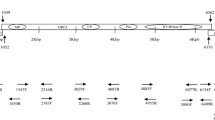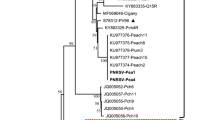Abstract
Fig mosaic virus (FMV), which was described recently, is the only characterized causal agent of fig mosaic disease (FMD). It has six RNA segments and belongs to the Bunyaviridae family. In order to determine the genetic diversity of Turkish FMV isolates, the most common fig cultivars showing FMD symptoms were collected from different fig-growing provinces of Turkey. Nucleoprotein (Np) and Glycoprotein (Gp) gene-specific primers of FMV were used for RT-PCR analysis. According to RT-PCR results, 71 of 90 samples from 20 different cultivars and unknown fig seedlings were found to be infected by FMV. Among them, 41 isolates were sequenced and subjected to phylogenetic analyses based on the partial Gp and Np sequences at the amino acid level by the neighbor-joining method. The isolates showed more than 80% identity with reference FMV isolates (Acc. nos. FM991954.1 and FM864225.2). Based on phylogenetic analysis, the sequences clustered into two main groups for Np and Gp regions. Significant relationships between FMV isolates based on geographic origin and cultivars were not observed.





Similar content being viewed by others
References
Çağlar, B. K., Fidan, H., Güldür, M. E., & Elbeaino, T. (2010). The prevalence of three viruses infecting fig in southern Turkey. Journal of Phytopathology, 159, 181–183.
Çağlayan, K., Elçi, E., Serçe, C. U., Kaya, K., Gazel, M., & Medina, V. (2012). Detection of Fig mosaic virus in viruliferous eriophyid mite: Aceria ficus. Journal of Plant Pathology, 94, 629–634.
Çağlayan, K., Medina, V., Gazel, M., Serçe, C. U., Serrano, L., Achon, A., et al. (2009). Putative agents of fig mosaic disease in Turkey. Turkish Journal of Agriculture and Forestry, 33, 469–476.
Çağlayan, K., Medina, V., Yigit, A., Kaya, K., Gazel, M., Serçe, C. U., et al. (2009). Transmissions of fig mosaic agents by the eriophyid mite, Aceria ficus Cotte (Acari: Eriophyidae). Journal of Plant Pathology, 91, 235.
Çağlayan, K., Serçe, C. U., Barutçu, E., Kaya, K., Medina, V., Gazel, M., et al. (2010). Comparison by sequence-based and electron microscopic analyses of Fig mosaic virus isolates obtained from field and experimentally inoculated fig plants. Plant Disease, 94, 1448–1452.
Condit, I. J., & Horne, W. T. (1933). A mosaic of the fig in California. Phytopathology, 23, 887–896.
Drake, J. W. (1993). Rates of spontaneous mutation among RNA viruses. Proceedings of the National Academy of Sciences, 9, 4171–4175.
Elbeaino, T., Digiaro, M., Alabdullah, A., De Stradis, A., Minafra, A., Mielke, N., et al. (2009). A multipartite single-stranded negative-sense RNA virus is the putative agent of fig mosaic disease. Journal of General Virology, 90, 1281–1288.
Elbeaino, T., Digiaro, M., De Stradis, A., & Martelli, G. P. (2006). Partial characterization of a closterovirus associated with a chlorotic mottling of fig. Journal of Plant Pathology, 88, 187–192.
Elbeaino, T., Digiaro, M., De Stradis, A., & Martelli, G. P. (2007). Identification of a second member of the family Closteroviridae in mosaic-diseased figs. Journal of Plant Pathology, 89, 119–124.
Elbeaino, T., Digiaro, M., De Stradis, A., & Martelli, G. P. (2009). Complete nucleotide sequence of four RNA segments of Fig mosaic virus. Archives of Virology, 154, 1719–1727.
Elbeaino, T., Digiaro, M., & Martelli, G. P. (2011). Complete sequence of fig fleck-associated virus, a novel member of the family Tymoviridae. Virus Research, 161, 198–202.
Elbeaino, T., Heinoun, K., Digiaro, M., & Martelli, G. P. (2010). Fig mild mottle-associated virus, a novel closterovirus infecting fig. Journal of Plant Pathology, 92, 165–172.
Elbeaino, T., Kubaa, R. A., Digiaro, M., Minafra, A., & Martelli, G. P. (2011). The complete nucleotide sequence and genome organization of Fig cryptic virus, a novel bipartite dsRNA virus infecting fig, widely distributed in the Mediterranean basin. Virus Genes, 42, 415–421.
Elçi, E., Serçe, Ç. U., Gazel, M., & Çağlayan, K. (2012). Molecular detection and comparative sequence analysis of viruses infecting fig trees in Turkey. Journal of Phytopathology, 160, 418–423.
Foissac, X., Svanella-Dumas, L., Gentit, P., Dulucq, M. J., & Candresse, T. (2001). Polyvalent detection of fruit tree Tricho, Capillo and Foveavirus by nested RT-PCR using degenerated and inosine containing primers (DOP RT-PCR). Acta Horticulturae, 550, 37–43.
Fraile, A., Malpica, J. M., Aranda, M. A., Rodrıguez-Cerezo, E., & Garcıa-Arenal, F. (1996). Genetic diversity in tobacco mild green mosaic tobamovirus infecting the wild plant Nicotiana glauca. Virology, 223, 148–155.
Gattoni, G., Minafra, A., Castellano, M. A., De Stradis, A., Boscia, D., Elbeaino, T., et al. (2009). Some properties of Fig latent virus 1, a new member of the family Flexiviridae. Journal of Plant Pathology, 91, 543–552.
Gençer, N. S., Coşkuncu, K. S., & Kumral, N. A. (2005). Bursa İlinde İncir Bahçelerinde Görülen Zararlı ve Yararlı Türlerin Saptanması. [Determination of useful and harmful species on fig orchards at Bursa province.]. O.M.U. Journal of Agriculture Faculty, 20, 24–30.
Ishikawa, K., Maejima, K., Komatsu, K., Kitazawa, Y., Hashimoto, M., Takata, D., et al. (2012). Identification and characterization of two novel genomic RNA segments of Fig mosaic virus, RNA5 and RNA6. Journal of General Virology. doi:10.1099/vir.0.042663-0.
Martelli, G. P., Castelleano, M. A., & Lafortezza, R. (1993). An ultrastructural study of fig mosaic. Phytopathologia Mediterranea, 32, 33–43.
Rubio, L., Abou-Jawdah, Y., Lin, H. X., & Falk, B. W. (2001). Geographically distant isolates of the crinivirus Cucurbit yellow stunting disorder virus show very low genetic diversity in the coat protein gene. Journal of General Virology, 82, 929–933.
Rubio, L., Ayllon, M. A., Kong, P., Fernandez, A., Polek, M., Guerri, J., et al. (2001). Genetic variation of Citrus tristeza virus isolates from California and Spain: evidence for mixed infections and recombination. Journal of Virology, 75, 8054–8062.
Salomon, R., Mawassi, M., & Flaishman, M. A. (2008). Isolation and characterization of a virus from fig leaves exhibiting mosaic symptoms and development of a sensitive detection procedure for this virus. Acta Horticulturae, 798, 259–262.
Schneider, W. L., & Roossinck, M. J. (2001). Genetic diversity in RNA virus quasispecies is controlled by host–virus interactions. Journal of Virology, 75, 6566–6571.
Serrano, L., Ramon, J., Segarra, J., Medina, V., Achon, M. A., & Lopez, M. (2004). New approach in the identification of the causal agent of fig mosaic disease. Acta Horticulturae, 657, 559–566.
Tamura, K., Peterson, D., Peterson, N., Stecher, G., Nei, M., & Kumar, S. (2011). MEGA5: molecular evolutionary genetics analysis using maximum likelihood, evolutionary distance, and maximum parsimony methods. Molecular Biology and Evolution, 28, 2731–2739.
Thompson, J. D., Higgins, D. G., & Gibson, T. J. (1994). CLUSTAL W: improving the sensitivity of progressive multiple sequence alignment through sequence weighting, positions-specific gap penalties and weight matrix choice. Nucleic Acids Research, 22, 4673–4680.
Tzanetakis, I., & Martin, R. (2010). New viruses found in fig exhibiting mosaic symptoms. 21st International Conference on Virus and other Graft Transmissible Diseases of Fruit Crops. Julius-Kühn-Archiv, 427.
Vives, M. C., Rubio, L., Galipienso, L., Navarro, L., Moreno, P., & Guerri, J. (2002). Low genetic variation between isolates of Citrus leaf blotch virus from different host species and of different geographical origins. Journal of General Virology, 83, 2587–2591.
Walia, J. J., Salem, N. W., & Falk, B. W. (2009). Partial sequence and survey analysis identify a multipartite, negative-sense RNA virus associated with fig mosaic. Plant Disease, 93, 4–10.
Acknowledgments
The authors would like to thank Prof. Dr. Bryce W. Falk and Dr. Jeewan Jyot Walia from the University of California-Davis for their kind help during the experiments. The authors also thank Prof. Dr. Anne Frary from İzmir Institute of Technology for the English editing of the manuscript. Eminur (Barutçu) Elçi is grateful to The Scientific and Technological Research Council of Turkey (TÜBİTAK) for International research fellowships (2214). This study was supported by TÜBİTAK-TOVAG 111O827 and Mustafa Kemal University-BAP-1202M0113 projects. Accession numbers: JQ173767–JQ173848
Author information
Authors and Affiliations
Corresponding author
Rights and permissions
About this article
Cite this article
Elçi, E., Serçe, Ç.U. & Çağlayan, K. Phylogenetic analysis of partial sequences from Fig mosaic virus isolates in Turkey. Phytoparasitica 41, 263–270 (2013). https://doi.org/10.1007/s12600-013-0286-0
Received:
Accepted:
Published:
Issue Date:
DOI: https://doi.org/10.1007/s12600-013-0286-0




